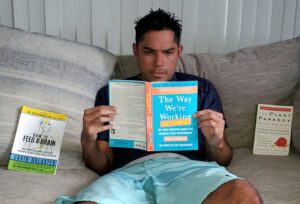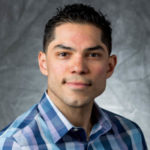
Dr. Mena says a few key books have provided valuable information on the nutritional and lifestyle recommendations he should give to patients.
Key business books to help you make better lifestyle and nutritional recommendations to patients.
By Vittorio Mena, OD, MS
August 16, 2023
“Knowledge is power,” it has been said, but that is only half the equation. The other half is applying that knowledge toward success for the future. You have to put the principles you learn from books into action. Here are a few books with important nutrition and wellness information I applied to my practice to improve care and become more profitable.
“The Way We’re Working Isn’t Working”
by Tony Schwartz
Schwartz discusses four frequently forgotten ways to energize great performance: physical (strength and endurance), mental (control of attention), emotional (positive energy) and spiritual (compelling sense of purpose). Schwartz states: “It is not the number of hours we work that determines how much value we create, but rather, the quantity and quality of energy we bring to whatever hours we work.”
We are not meant to run like high-speed computers because doing so eventually leads to burnout or breakdown. Our most basic survival requires us to spend and renew energy by eating right, staying fit and getting adequate sleep. When we are irritable or tired, it not only is reflected in a lower quality of patient care delivered, but it can also take a toll on our family life.
I keep the principle of work-life balance in mind when managing employees. This has resulted in employees who are more energized and engaged with their work. Schwartz notes that when a company has the most engaged employees, there is a 19 percent increase in operating income and 90 percent of that company’s employees have no plans to leave the company. Those companies that have less engaged employees have a 32 percent decline in operating income and 50 percent of their employees considered leaving.
There have been more than 100 studies demonstrating the correlation between employee engagement and business performance. The bottom line is to ask yourself: Is the way you are practicing costing you in the long run? How motivated or engaged are you with patients and employees? We are creatures of habit with 95 percent of our behavior occurring because that’s just the way we have always done it. It’s important to think consciously about the choices you are making in how you manage your employees and yourself.
A positive, upbeat attitude from an energized doctor and staff will result in patients coming back to see you year after year and referring many others to your practice.
“How To Feed A Brain”
by Cavin Balaster foreword by Dr. Datis Kharrazian
This book tells the real-life story of Balaster, who suffered a traumatic brain injury (TBI) after falling from a rooftop water tower. This fall left him comatose with less than a 10 percent chance of regaining consciousness. If he did regain consciousness, doctors said he would remain in a vegetative state.
When someone suffers a TBI, doctors refer to the Glascow coma scale, which assesses the depth and duration of a coma and impaired consciousness. It will give a score based on motor and verbal responses and whether the eye responds to pain or touch. The score ranges from 3-15 with the higher the score the “milder” the injury. Balaster’s score was a 3, which is referenced as a severe TBI.
Through years of research with doctors, nutritionists, neuroscientists, professors and other practitioners, Balaster regained consciousness and mobility.
Other Articles to Explore
Balaster discusses the importance of the high-quality, non-oxidized fish oils that helped him. The best versions of these oils are the reformed re-esterified triglycerides since they are metabolized and absorbed more efficiently than ethyl ester versions. The most important brain nutrient is DHA (docosahexaenoic acid), which studies have shown to be extremely useful in speeding TBI recovery and increasing neuro-protection.
Reporting in the American Journal of Emergency Medicine (2013) showed the power of Omega-3s in waking comatose patients and accelerating neurological recovery. You can find DHA in fatty fish like salmon, mackerel, anchovies, sardines and herring. Most Americans do not typically eat the recommended two servings of fish a week. The other way to get these nutrients into your diet is to supplement since we cannot manufacture these oils on our own.
Balaster’s story drove home for me the importance of talking to patients, including those with TBI, about nutrition. For high-quality fish oils, I recommend either Nordic Naturals Ultimate Omega 2X or TG Omega-3 from MacuHealth. Not only are these fish oils helpful for the brain, but beneficial for the eyes, skin and heart health. My personal preference of the two choices is TG Omega-3 because it has a 1:1 ratio of DHA to EPA.
We sell these supplements in-office for patients. The price to the practice of MacuHealth ranges from $23-$25 for each bottle sold. The practice profits about $20 a bottle. If a patient takes it twice a day they would need six bottles for the year, which means the practice profits $120 per patient, and if they take it four times a day, they would need 12 bottles annually, which would generate $240 per patient yearly.
“The Plant Paradox”
by Dr. Steven Gundry
Dr. Gundry, a major advocate for restorative medicine, discusses the surprising truths about the food we consume everyday. As doctors, we are taught conventional medicine with treatments involving surgeries and medications. Sadly, we are not taught enough about the role diet plays in maintaining good health.
Hippocrates, the father of modern medicine, stated that all diseases begin in the gut. Our gut plays a crucial role since the brain and gut are tied via the Vagus nerve (cranial nerve X). Ninety percent of our serotonin and 70 percent of our melatonin is found in our gut. This helps control our sleep, mental health, digestion, skin health and immunity.
Dr. Gundry shares his experience going on a lectin-free diet to support immune health. Lectins contribute to leaky gut and autoimmune diseases such as rheumatoid arthritis, multiple sclerosis, lupus, Celiac disease and Hashimoto’s thyroiditis. Lectins, which are found on certain plants, are sticky proteins that are used as the plant’s self-defense mechanism. Lectins bind to carbohydrates, so that eating them in high quantity can damage the gut lining and blow microscopic holes through your gut wall allowing unwanted particles inside. When this happens, autoimmune diseases and inflammation can occur.
One type of lectin is gluten. People who do not have Celiac’s disease should NOT all be on a gluten-free diet, but it’s important not to over-consume gluten. The inflammation, which lectins like gluten can contribute to, also impact eye conditions like dry eye, diabetic retinopathy and macular degeneration. For that reason, I discuss with my patients which foods to avoid or eat in smaller quantity.
Most Important Point I took from All 3 Books
Whenever we consume food, drink water, breathe air or take in sunlight, many biochemical reactions occur in our body and brain. These reactions can generate growth, healing and energy. We all hold the keys to our own health. I educate my patients to unlock that door and lead a healthy, beautiful life. My patients see the positive impact this education has on their lives and they consistently return for care.
 Vittorio Mena OD, MS, is the sports vision director with Optical Academy. To contact him: menavitt@gmail.com
Vittorio Mena OD, MS, is the sports vision director with Optical Academy. To contact him: menavitt@gmail.com

























